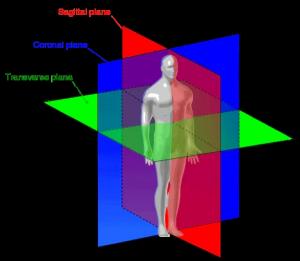
The Brookbush Institute Publishes NEW Course and Glossary Updates: 'Planes of Motion'
The Brookbush Institute continues to enhance education with new courses, a modern glossary, an AI Tutor, and a client program generator.
- From the Course: Lesson 2: Planes of Motion
- Prepare for the Brookbush Institute: Certified Personal Trainer (CPT) Certificate
DEFINITION
Planes of motion are imaginary two-dimensional surfaces that divide the body relative to directions of motion (forward, sideways, rotation, etc.). The planes of motion are a standardized reference system used to aid in analyzing joint actions, motion, body position, and anatomical locations. There are three primary planes of motion used in anatomy and kinesiology: the sagittal plane, the frontal plane (coronal plane), and the transverse plane (horizontal plane).
These planes are also known as cardinal planes:
- Sagittal plane : The sagittal plane divides the body into left and right halves and refers to a motion that is forward, backward, up, and down, such as a squat or suspension row .
- Frontal plane (coronal plane) : The frontal plane divides the body into front (anterior) and back (posterior) halves, referring to motion that is side to side and up and down, such as a jumping jack, wide-grip pull-ups , or military press .
- Transverse plane (horizontal plane): The transverse plane divides the body into top and bottom halves and refers to motion in which the arms or legs start parallel to the horizon and come together (horizontal adduction) or spread apart (horizontal abduction) or when joints rotate or pivot. Examples include bench press , axe chops , and seated adduction.
Additional Plane:
- Scapular Plane: The scapular plane is the plane of the scapula. It is medially rotated approximately 30-40 degrees from the frontal plane (between the frontal and sagittal planes). The scapula's medially rotated position is due to the elliptical shape of the rib cage. Although this is not a cardinal plane, it is sometimes used to describe upper extremity motion.
FREQUENTLY ASKED QUESTIONS (FAQS)
Why are planes of motion important in exercise?
- They help describe how the body moves and ensure balanced training. Many real-world and sport-specific tasks require movement across multiple planes, and training in all three can enhance functional strength, coordination, and reduce the risk of injury.
What plane of motion is walking in?
- Walking is primarily a sagittal plane movement, involving flexion and extension at the hip, knee, and ankle. However, some trunk rotation and pelvic movement also occur in the transverse and frontal planes, especially at faster speeds.
What plane is a squat in?
- A squat is performed in the sagittal plane, as the hips, knees, and ankles move forward and backward (flexion and extension).
What is a multiplanar exercise?
- A multiplanar exercise involves movement across two or more planes of motion. For example, a lunge with a torso twist combines sagittal (lunge) and transverse (rotation) planes.
How do planes of motion relate to axes of rotation?
- Each plane of motion corresponds to a perpendicular axis of rotation: Sagittal plane → mediolateral axis; Frontal plane → anteroposterior axis; Transverse plane → vertical (longitudinal) axis. Understanding these relationships helps in analyzing joint actions.
FOR THE FULL TEXT AND SO MUCH MORE, CLICK ON THE LINK
Brent Brookbush
Brookbush Institute
email us here
Visit us on social media:
LinkedIn
Instagram
Facebook
YouTube
TikTok
X
Other
Distribution channels: Education, Healthcare & Pharmaceuticals Industry, Science, Social Media, Sports, Fitness & Recreation
Legal Disclaimer:
EIN Presswire provides this news content "as is" without warranty of any kind. We do not accept any responsibility or liability for the accuracy, content, images, videos, licenses, completeness, legality, or reliability of the information contained in this article. If you have any complaints or copyright issues related to this article, kindly contact the author above.
Submit your press release
